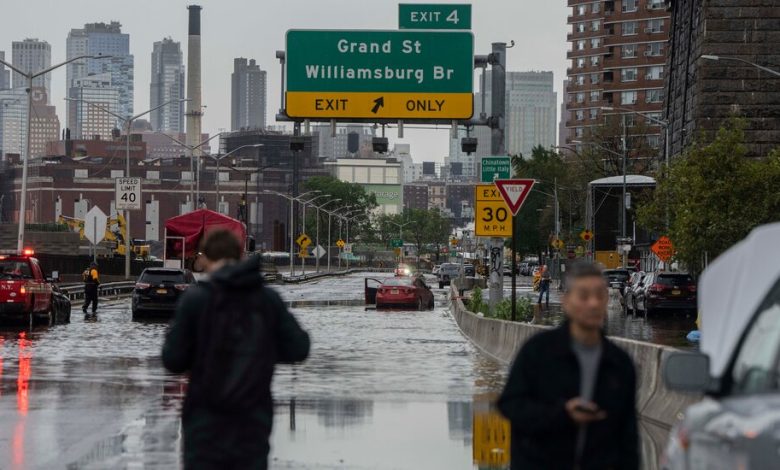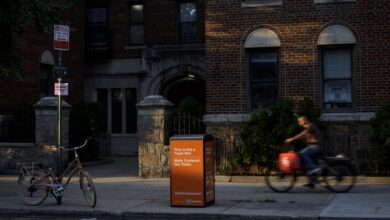Was New York City Unprepared to Handle Last Week’s Extreme Rainfall?

Six days after the remnants of Tropical Storm Ophelia paralyzed New York City, trapping children in flooded schools and halting swaths of subway and railroad service, the city’s preparation for the storm and its response are facing scrutiny.
The city comptroller, Brad Lander, told Mayor Eric Adams on Wednesday that he was launching an investigation into the city’s management of extreme rainfall, just two years after Hurricane Ida inundated the five boroughs and killed 13 New Yorkers.
The comptroller’s review will be supplemented by a separate City Council oversight hearing on the city’s storm preparations. Gale Brewer, the councilwoman who chairs the Oversight and Investigations Committee, said she was troubled by the city’s lack of communication in advance of the storm.
“I would say, definitely needs improvement,” Ms. Brewer said.
Mayor Adams did not brief New Yorkers on the storm until after the epicenter had begun to move north of the city on Friday, drawing concern about his crisis management skills as well as about the city’s ability to withstand heavy rainfall.
“There was an opportunity to give people a heads up so they could plan safely their movements the next day,” said Eddie Bautista, executive director of the New York City Environmental Justice Alliance. “I’m just aghast.”
Storms have a long New York City history of damaging mayoral reputations, though typically those storms have involved snow. Mayor John V. Lindsay’s mismanagement of a 1969 snowstorm endangered his re-election prospects. In 2010, Mayor Michael R. Bloomberg was forced to acknowledge his own mismanagement of a blizzard.
After Hurricane Ida dumped more than three inches of rain an hour on New York City in 2021, the city published a 66-page playbook for extreme weather called “The New Normal.” In it, the administration of Mr. Adams’s predecessor, Bill de Blasio, promised to appoint an “extreme weather coordinator” in the mayor’s office, deploy a “more aggressive early warning system” tailored to the at least 100,000 New Yorkers who live in basement apartments, and create a database of basement apartments.
Soon after, Mr. Adams replaced Mr. de Blasio, and midway through his first year, he released another plan, called “Rainfall Ready,” which, among other things, contemplated lowering lake levels in several parks to enhance their ability to absorb rainwater.
It remains unclear how many of those steps contained in those two plans the city has taken, and Mr. Lander will review whether the city has followed through on them.
“After Hurricane Ida, the City of New York committed to improving the city’s emergency preparedness, communications, and infrastructure in response to extreme weather,” Mr. Lander wrote in a letter to the mayor.
“Obviously, time is of the essence here,” Mr. Lander said in a separate interview on Wednesday. “There’s reason to be anxious that every hurricane season we could be vulnerable.”
Although Mr. Adams was silent about the storm the day before its arrival, the city was not entirely unprepared. It launched its flash flood management plan the day before the storm hit, and its emergency operations commissioner did two media interviews, which the mayor argued should have been sufficient.
The city sent out electronic notifications to its Notify NYC system, which has 1.1 million subscribers. The city’s Department of Environmental Protection cleared some catch basins and urged New Yorkers to deploy the 5,000 flood barriers that the agency has handed out in the past year.
Other agencies performed more haltingly, and some New Yorkers said the absence of a well-communicated directive from the city made things worse.
At a public housing building on West 64th Street in Manhattan, the rain colluded with a clogged storm drain to flood an early education center on the ground floor and the walk-in basement.
Shortly after parents had dropped off their children for the day, the children had to be relocated or sent home.
“We were caught off guard by how intense the weather was,” said Ken Jockers, the executive director of Hudson Guild, the organization that runs the center. “And we didn’t have any sort of advance instruction about the fact that there was a weather emergency coming and whether places like ours should be open or closed or have an alternative plan for that day.”
Normally, Mr. Jockers would have followed the lead of the Education Department. On Tuesday, the schools chancellor conceded that communications could have been better and promised an after-action report.
Even so, Mr. Adams has described his performance as a success, noting that there were no deaths attributed to the flooding. He accused those who were unaware of the coming deluge of “living under a rock.”
On Wednesday, the mayor adopted a more conciliatory tone, praising the hard work of city employees, the rescues they conducted and the infrastructure upgrades they brought to the Jewel Streets neighborhood of Queens, which he said helped alleviate flooding within hours, “rather than within the weeks” necessary after Hurricane Ida.
“At the same time, our administration is thinking creatively and acting aggressively to prepare New Yorkers and our city for the ever-growing threat of severe storms — including through our Capital Process Reform, which has put forward reforms to accelerate major infrastructure projects,” the mayor said. “We welcome a fair, thorough, and balanced review to ensure our city is equipped as these storms become increasingly frequent and severe.”





